Growing Blog
How To Build A Shotgun Fruiting Chamber (SGFC) in 5 Easy Steps
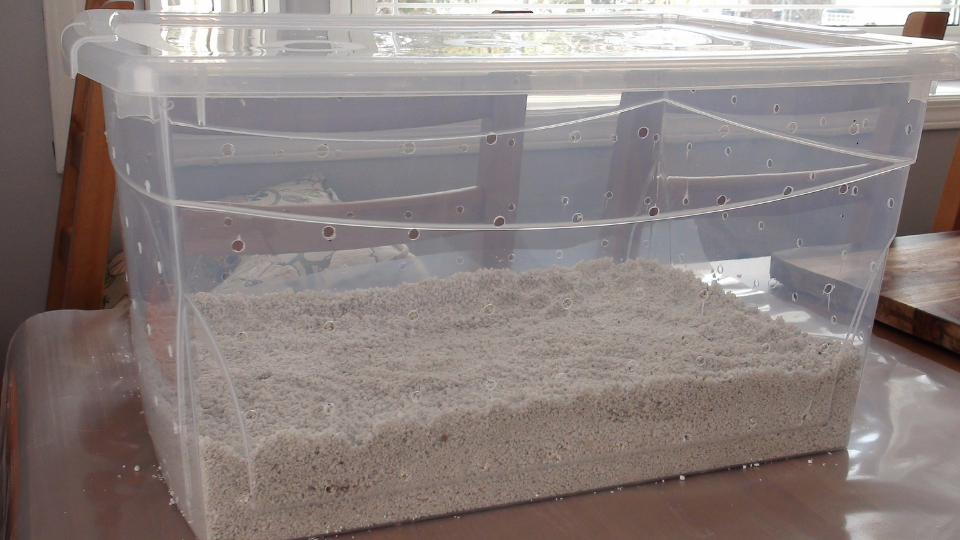
Contents
- What is an SGFC?
- What is Perlite?
- Building a Fruiting Chamber
- STEP 1: Mark Out The Holes
- STEP 2: Drill The Holes
- STEP 3: Fill The Bottom With Perlite
- STEP 4: Soak Your Perlite
- STEP 5: Place Your Mushroom Block in the Fruiting Chamber
- How to use a Shotgun Fruiting Chamber
- Lighting for Your Fruiting Chamber
- A Quick and Easy Solution
We like to pick mushrooms. Unfortunately, mushrooms themselves are picky – and getting mushrooms to fruit properly requires that we present them with ideal growing conditions.
Building a Shotgun Fruiting Chamber (commonly referred to as an SGFC) is a quick and easy way to provide the perfect balance of fresh air and humidity that mushrooms demand.
What is an SGFC?
A shotgun fruiting chamber is nothing more than a good sized clear tote, covered in holes, and filled with a few inches of wet perlite in the bottom.
The holes allow for fresh air and gas exchange, while the perlite serves as a way to maintain humidity. The tote should be clear in order to allow for an adequate amount of natural light to be passed through to your mushrooms.
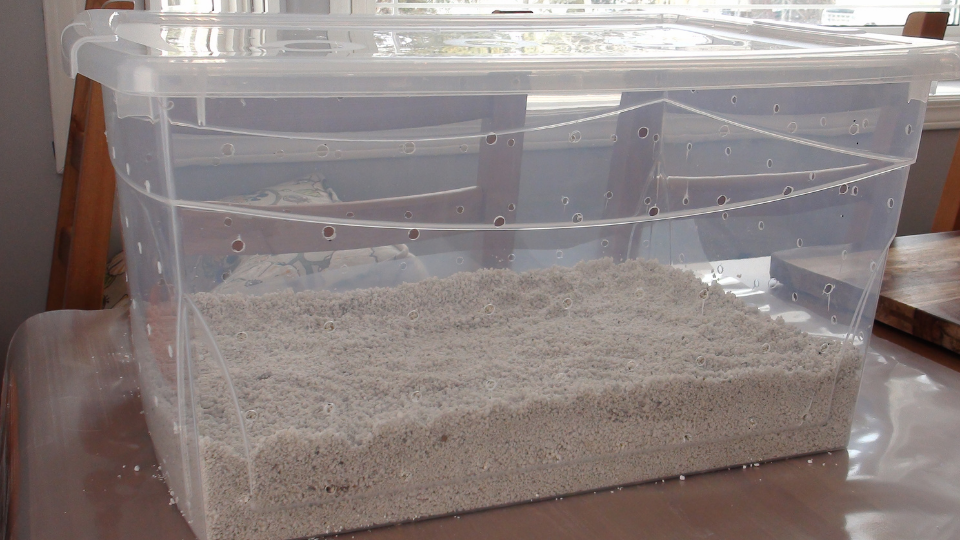
A simple shot-gun fruiting chamber. The name comes from the hole pattern on the tote.
What is Perlite?
Perlite is a natural volcanic mineral that, when expanded, forms a coarse and porous granule with a large relative surface area. All the nooks and crannies in the perlite granules are able to hold water, which evaporates over time. This evaporation from the perlite is what allows for the high relative humidity in your fruiting chamber.

A small pile of coarse perlite. You should be able to find it at your local garden center.
Building a Fruiting Chamber
Building a proper Shotgun terrarium won’t take too long at all, and only requires a few common tools. Once you get the materials you require, you should be able to build your SGFC in less than an hour.
Materials Needed
- A clear Plastic Tote (about 70 QT)
- Coarse Perlite (about 10-12 QT)
- A Spray Bottle
- Hygrometer (optional)
Tools Needed
- A Power Drill with a ¼” bit
- Measuring Tape
- Sharpie Marker
STEP 1: Mark Out The Holes
In order to get proper air flow through the SGFC, you want to have evenly spaced holes on all 6 sides of your tote- including the lid and the bottom. General consensus is that spacing for the holes should be an even 2” grid. Mark out all your holes with a sharpie.
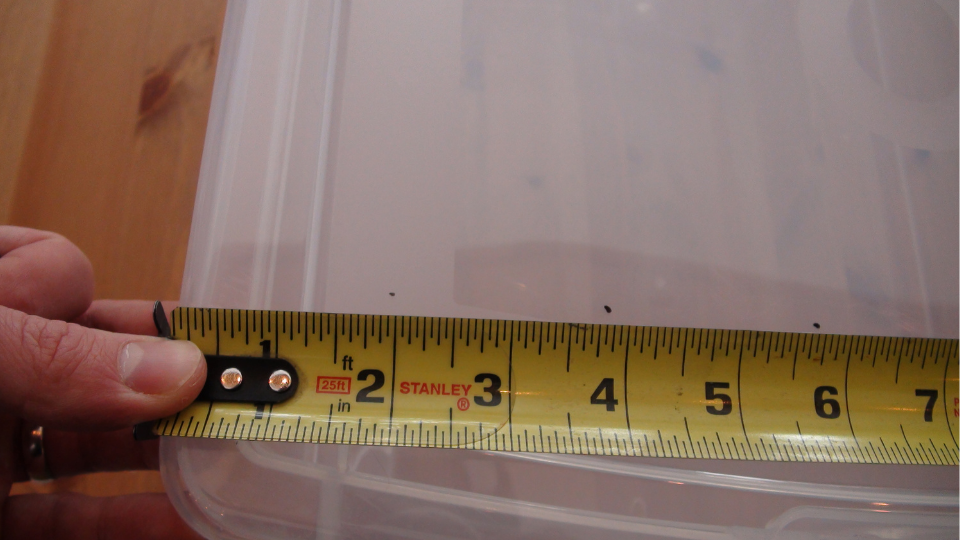
Mark out your holes spaced 2 inches apart in a grid.
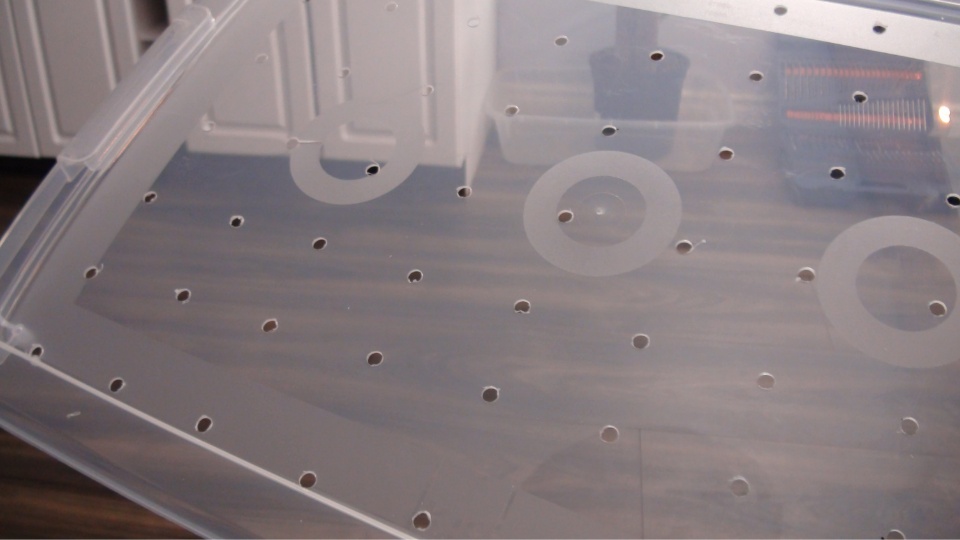
Holes should be drilled on all 6 sides, including the lid and the bottom.
STEP 2: Drill The Holes
Using a ¼” drill bit, drill out all the holes you marked out. Make sure you don’t press too hard or else the tote will crack as you are pushing the drill through. You will also need to ream out the holes and make sure there are no shards of plastic stuck on the edge. This is a repetitive task, but shouldn’t take all that long.
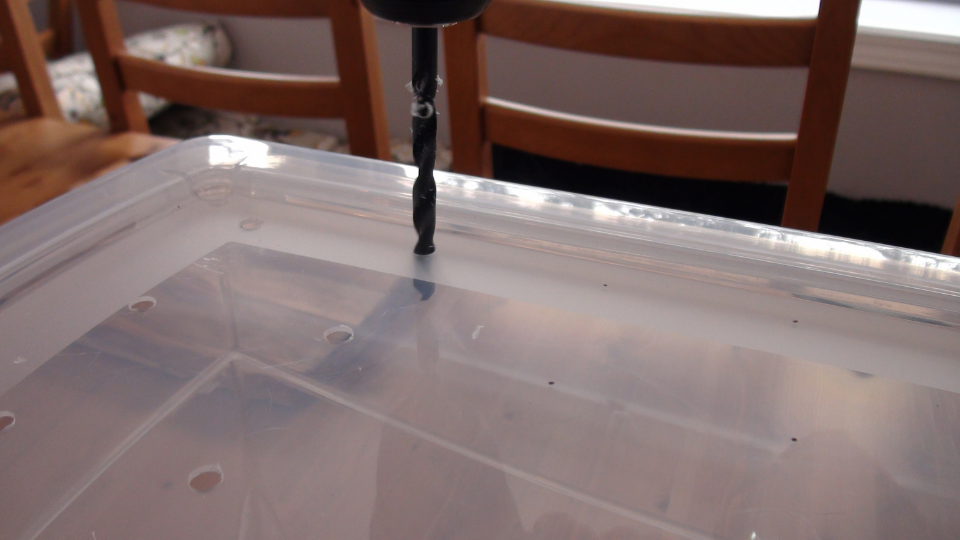
Use a 1/4″ drill bit to drill all the holes. This takes a little while!
STEP 3: Fill The Bottom With Perlite
Fill the bottom of your SGFC with a couple inches of perlite. The exact amount doesn’t matter too much, just make sure that you have enough to evenly cover the bottom of the tote with a few inches.
You also want to make sure you use coarse perlite. If the grind is too fine, you will have a lot of perlite coming through the holes you drilled, making a mess of things. Fine perlite also won’t hold as much water as coarse perlite can.
STEP 4: Soak Your Perlite

The perlite should be wetted until it is thoroughly moist.
Soak the perlite by pouring water into your SGFC and mixing it around until the perlite is evenly moist. There is no need to soak it so much that water is pouring out the bottom of the tote. The intention is just to coat the perlite in water so that in can evaporate over time, increasing the humidity in your SGFC.
STEP 5: Place Your Mushroom Block in the Fruiting Chamber
You now have a reasonably humid environment able to exchange gasses and receive fresh air- perfectly adequate chamber for growing all sorts of mushrooms on a small scale.
A typical use for a SGFC is to grow mushrooms using the PF technique, but you can just as easily use a shotgun terrarium with supplemented sawdust fruiting blocks, or even mushroom grow kits.
Although not entirely necessary, a hygrometer is a useful tool that can be placed in your fruiting chamber to help you monitor and manage the humidity levels. It will give you a really good idea of whether or not you need to spray the inside of the chamber. Over time, you will learn what humidity levels work best for different stages of the fruiting cycle.
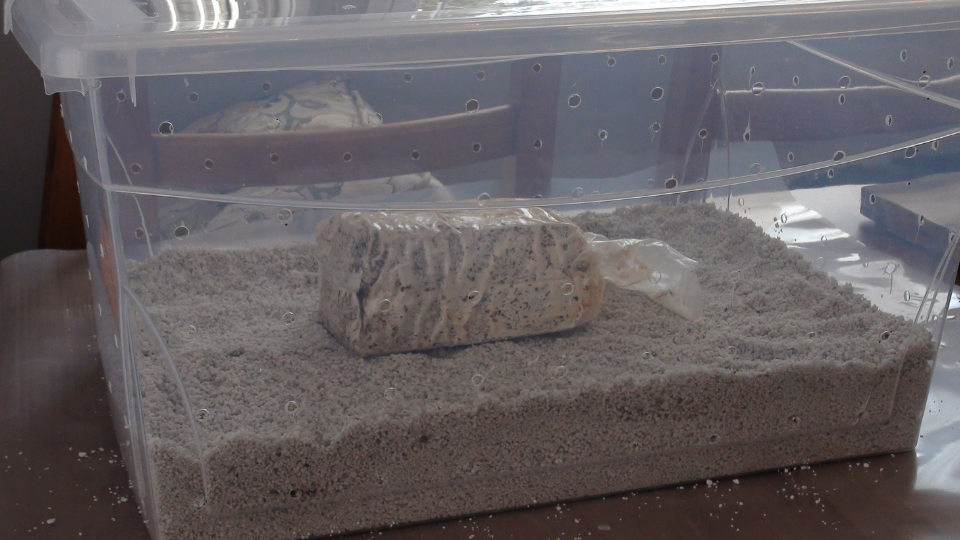
A small mushroom block sitting in a humid fruiting chamber
How to use a Shotgun Fruiting Chamber
SGFC’s are almost maintenance free, but there are still some best practices you should follow when using the SGFC tek.
Fanning and Spraying
The holes on all 6 sides of your fruiting chamber provide a means for gas exchange, and allow for fresh air, but the holes alone are not enough. Once your mushroom blocks are placed in the chamber, you should be removing the lid and fanning in fresh air at least twice a day.
In order to keep the humidity up after fanning in dry air, you’ll need to mist your chamber. To do this, simply use a typical spray bottle, and thoroughly soak the inside walls and the perlite foundation with water.
Try to do this without directly spraying the mushroom block, as droplets of water on the mycelium or the mushroom fruit body can cause problems such as bacterial blotch.
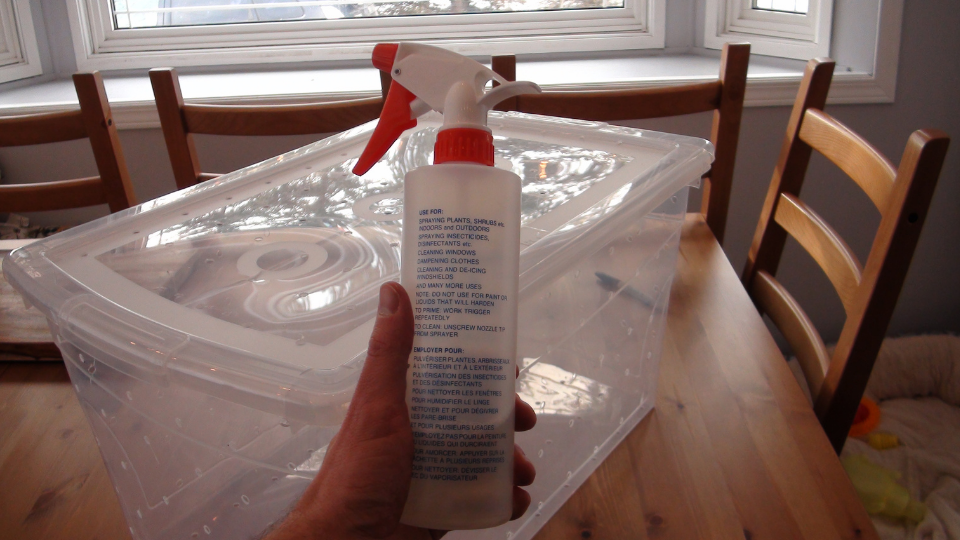
A simple spray bottle for misting your chamber.
Using a Hygrometer
A hygrometer is a useful tool to monitor the humidity in your grow chamber. Although not entirely necessary, it will help to give you an idea of whether or not you are providing an adequately moist environment.
Depending on the stage of the mushroom fruiting cycle, you’ll want your humidity to be in the range of 75%-90%. If the humidity drops too much, your mushrooms may have smaller, cracked caps, or may not even fruit at all.
It doesn’t matter if you can get a digital hygrometer or an analog one; just ensure that the range of the device is such that it can measure relative humidity all the way up to at least 90%. Some household hygrometers won’t accurately measure that high.
Look for the types of hygrometers that they use in humidors, which can accurately measure high relative humidity levels.
Lighting for Your Fruiting Chamber
Contrary to popular belief, most mushrooms do need adequate amounts of light in order to form proper fruiting bodies. However- they need this light for different reasons than other plants do.
The best location for your fruiting chamber is a place where it will receive natural indirect sunlight for most of the day. Direct sunlight will be detrimental to your grow, as it will heat up your growing chamber too much and may cause your mushrooms to abort.
Indirect natural light natural light is by far your best bet, such as near a window but away from the rays of the sun.
If you don’t have the option of providing natural light to your fruiting chamber, you could always supplement with artificial light. A good option would be to use a small florescent light on a timer, cycled 12 hours on and 12 hours off each day. This will simulate a natural light cycle.
If you choose this option, make sure that the light source is far enough away that it won’t overheat your chamber.
A Quick and Easy Solution
There are a million ways to build an elaborate growing chamber- with automated humidifiers, powerful fans and tons of space- but there is definitely nothing wrong with using a shotgun fruiting chamber to start.
Although they are simple and easy to build, they really do a great job of providing the ideal conditions mushrooms need to fruit properly. This makes the Shotgun Fruiting Chamber a great choice for new growers looking to learn, or even experienced growers who want a quick and easy grow chamber for running experiments.
Thanks for reading! Feel free to let us know of your experience with SGFC’s in the comments below.
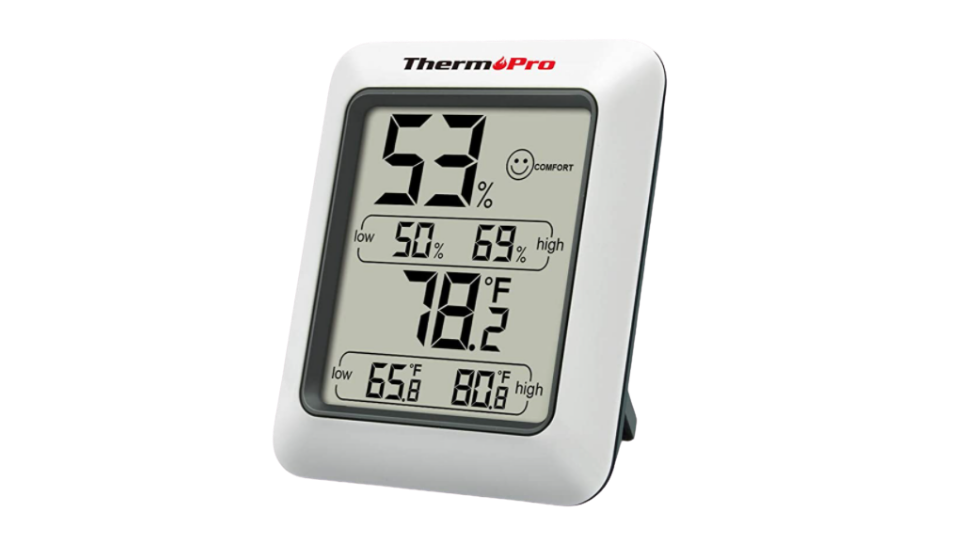

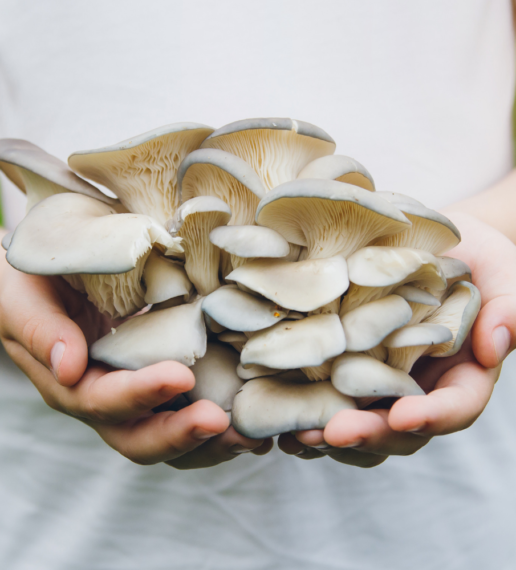
Thanks for the write up, think the most challenging work is maintaining humidity for people in the tropic.Keep it up
Hi there! I would think that the air would be adequately humid in the tropics, but the issue would be maintaining a cooler temperature? Some mushrooms though, like Pink Oysters and Yellow Oysters are tropical species which can do quite well in warmer climates. Where I grow mushrooms in Canada, humidity can fluctuate wildly depending on the weather, so a SGFC helps maintain some consistency. Thanks for reaching out and all the best in your grows!
Great write up. I just got into this, I am getting my first kit in the mail tomorrow and I’m anxious to get started. I have spent all my free time the last 5 or so days reading up on the process. I have been wondering about a good way to keep the environment right for the fruiting block and it looks like I just found it. I plan on trying a few different kinds, I am mostly interested in Reishi and Lion’s Mane, but also in something that can produce a lot of fruit.
Hey Justin,
Thanks for reaching out! Reishi and Lions Mane should do great in a SGFC. Lions Mane need a little more humidity than Reishi- but both are relatively easy to grow. If you are looking for something that can produce a lot of fruit you should consider Pink Oyster Mushrooms- especially with summer on the way!
Thanks for the detailed writeup!
I’m wondering if the bin size you link to will hold 12 half-pint cakes?
Hey Eric! The 70 qt should definitely hold 12 cakes.
Is there any possible alternative to drilling holes with a power drill?
Maybe a knife, or ice pick, or burning holes with a lighter/hot poker…?
Sure! Power drill definitely works best, but anyway you can get a bunch of holes in the tote should work. Stay safe though!
when using plastic totes, drilling tends to crack the plastic either by to much pressure on the bit or as it punches through. I use a butane torch and a 1/4 inch metal rod I sharpened a point on…I then heat up the rod, an easily melt a hole through the plastic. not only does this ensure I don’t crack the plastic, but it also cauterizes the edges of the holes so they don’t crack after the hole has cooled. Just remember to do this outside, or in a well ventilated area with a respirator. The fumes are noxious…but the method works GREAT!
Blowtorch and a metal rod works well. Similar to heating a coffee can on a stove burner to punch arm holes when making a Still-Air Box. Go slowly to avoid cracking the plastic.
A hammer and a nail is an option. Works best when used with a piece of wood to prevent stress cracking the container
I used a nail that I was heating with a candle. It was a long process, but easier in my opinion than a drill on plastic.
The photo of the grain bag above is a bit confusing. How is the fully colonized bag supposed to fruit if its still in a bag? Do you need to open the bag? What about adding substrate?
Hey Sorcha! That bag is actually a pre-made fruiting block of blue oyster. It is the same one that I grew here: https://learn.freshcap.com/learn/mushroom-grow-kits/ There was a few holes that were sliced in the bag for the mushrooms to grow through. Hope that clears things up!
Hi Tony
First of all what you are doing with this site is incredible! Thank you!
This is exactly what I need right now 🙂 I’m waiting for my first kit with Lions Mane mushrooms.
For this occasion I purchased 120 qt plastic tote. But I’m a bit concerned about drilling the holes.
It will be sitting on the wired shelf so I can’t drill the holes on the bottom of the tote and not sure about drilling too many holes in general in order not to lose the humidity. What if I add ventilation with the computer fan, with air movement from the top to the bottom close to one of the sides? Theoretically it should work. Should I turn it on/off with the intervals or leave it working continuously?
Or I shouldn’t be concerned about the humidity loss and just go and drill the holes on all sides but the bottom?
Thank you
Hey Valeriy,
Thanks for reaching out! I am glad you like the site! I would go ahead and drill holes on all sides including the bottom and simply place a sheet of plastic or a garbage bag underneath the tote to catch any excess moisture. You could also go without drilling the holes on the bottom and likely be just fine. I would hesitate to blow a fan directly at the kit, it could dry it out to much. Instead, just open the tote and fan it with the lid a few times per day.
Happy growing!
Tony
Hey toney,
I was just wondering if you think it’s absolutely necessary to have a transparent lid on my fruiting chamber?
Hey Anthony!
Great question- and I would say no, it’s not absolutely necessary. The clear lid helps get some extra light in the chamber, but you will likely do just fine with an opaque lid.
Hi,
How do you stop the perilit from falling out the bottom holes?
Do you use micro pore tape or something similar?
Hey Chris! It actually doesn’t fall out too much as long as the chamber stays in the same place most of the time. I usually put a sheet of poly or something similar underneath to collect any perlite that might want to come out. Micro pore tape would also likely work very well.
I’m thinking of using a spare 50gal aquarium as a chamber…I plan on attaching a fan to a piece of hosing with holes drilled to exhaust Co2 as well as one set the same way only backwards to pull in fresh air. These will both vent and pull thru a plexi lid. Is this a bad idea
Great site. I have built three fruiting chambers for our annual organic gardening event. I am growing 6 varieties of mushrooms in these chambers. Block instructions say to leave block in bag, soak for 24 hours, them place near window and mist daily. In the fruiting chamber the high humidity is more consistent. Is it still necessary to soak block for 24 hours prior to placing in container? Instructions say to slit bag on one side only , but presumably with 5 sides exposed to environmental conditions inside chamber you could slit bag on all sides?
Do you need the bag at all if you cover the block with a fruiting cap of peat and perlite?
Thanks for reaching out! I would say it is not necessary to soak the block, but it definitely doesn’t hurt. Typically with fruiting blocks, there is already enough moisture in the block for good fruits- just keep the humidity up in the fruiting chamber as you suggested. I would hesitate to remove the whole bag though- this will likely cause the block to dry out too much. Typically works great for shiitake but not much else.
Hi! Thanks for this great write up!
I am going to built such a chamber, but I wonder about the possible odors that come with fruiting mushroom (Oysters for now). Does it smell? My girlfriend doesn’t like mushroom and wishes I would put this tote outside the house because she fears mushroom odors. (Canada) I am concerned about bugs that could come in the tote if I put it outside. Could I make less holes to the side (say, 2-3 rows) and top and cover the holes with tyvek or autoclave fabric (blue SMS fabric) to prevent bugs to get in but still have some air exchange? There would still be holes at the bottom but I guess it’s less problematic for bugs to get if I lift the tote 4-5 inches off the ground.
Thanks in advance for your input!
Hey Jim! To be honest, it doesn’t really smell (unless it gets contaminated). If anything, it just has a really nice mushroomy smell. I would go for it, and if it becomes a problem, then move it outside… you will likely get bugs who want your mushrooms!
Does tote have to be clear?
Yes, at the very least the lid should be clear. That will allow the proper amount of ambient light to come through.
Do you continue misting and fanning after pins form? And if so, at the same rate?
Yes, you want to maintain the humidity and fresh air. It can be a little less humid than when trying yo initiate pinning, but you still want it to be moist. You’ll be able to tell if the mushrooms are getting too dry.
Hi tony.
Do you have any suggestions on how to keep the fruiting box at an adequate temperature. It currently winter in my corner of the globe and I am looking at growing some warm climate mushrooms such as golden oyster.
Thanks
Hey James! Yellows can still grow at reasonably low temperatures. If you are trying to warm it up, you could consider placing it on top of your refrigerator, there is usually some extra warmth up there. But in general, room temperatures are perfect.
If I placed this in a larger tub. Could I just simply add water to the larger tub to a point below the substrate and let it soak into the perlite through the holes In the tub?as well as constantly keeping the perlite wet it would provide alot of humidity.
Hey Ben, definitely worth a shot, although too much standing water could invite contaminates.
Hi Tony,
I was given a large flow hood, but the only place I think of to place it is in the barn/ open work area. Will this be ok or should I build a room to accommodate.
That is awesome! It is hard to say for sure… I have had luck using a flow hood in all sorts of areas, with carpet, dogs ect. even in dirty garages… so you are likely OK. Just make sure that anything in the flow is clean, and that you have a pre-filter on your flow hood. Best of luck!
Hi Tony, Thanks very much for sharing your information. I am only just starting out and your site has helped me massively already.
I was wondering if it is possible to grow 2 different mushroom types in the same Shotgun Container or should they be kept well away from each other?
I have made some PF Tek cakes, 4 X Lions mane and 4 X blue oyster. I would like to experiment with growing a variety of Fungi in the future but cant find much information about growing different types near each other.
Any advice from you or anyone else would be greatly appreciated
Hey Chester! Yes, that is definitely possible to do. I have grown Lion’s Mane and Blue Oyster in the same SGFC, and I am certain it can work for other species aswell. I was actually going to post a video with this very thing 🙂
I’m gonna try fruiting trays inside my SGFC. I’ve been successful with trays inside a monotub, but I’m curious to see if trays will fruit well in my SGFC as well.
Hey There Tony,
I am a first time grower and all your videos have really made this new adventure so exciting. I purchased some liquid culture to inoculate some sterilized rye grain. I have already constructed my SGFC but I am still unsure of when to place the block in the chamber. Do I wait until the bag is completely white or can I put it in the fruiting chamber immediately after inoculation? I find your videos the easiest to understand, so I thought maybe you could help me! Thanks a bunch for your time – Jamie 🙂
Hey Jamie! Thanks for checking out the site and videos! For an SGFC, wait until the block is fully colonized before you put in the chamber.
hello, can you give me an idea of what temperature range I`ll need for fruiting?
Hey there! Room temperature (17-22 deg C) is great for most mushroom types 🙂
Lot this post. Helped me a lot.
I do have a question. The Perlite you linked to in Amazon is super coarse type with sizes the size of a pea and as much as 1/2″. Is this the right type of Perlite?
Another solid write-up. So, what would the next step be for the at-home hobbyist, who wants to grow 1-2 mycobags at a time and doesn’t want to spend every day fanning and misting?
You could spawn to bulk using a monotub. Meaning when the mycelium blocks have fully formed, open the bags, cut the blocks up and put it in another substrate lol inside a Monotub, certain monotubs are self sufficient so very little maintenance
Tony, great article (a noob question) do you drill holes on the bottom? I read people say that is a must and then use another chamber underneath filled with water to keep the top chamber temp up. I have a warm enough area when I do not need a water filled camber, so are holes on the site by the Perlite good enough? Do you need holes on the bottom?
I drill holes in the bottom, but of a pain because you will get some leakage, but just put some poly or a garbage bag underneath it 🙂 better than having water pool at the bottom. Hope that helps!
Hi there, thanks for all the info. I’ve just started looking into things as my first attempt without research failed miserably lol. I was just wondering if it could be possible to use sponge instead of perlite?
Thanks for the great information! Can you really just place the bag of substrate plus mycelium directly on top of the moist perlite? Is that not a problem for the bags? I would think direct contact with the moisture might cause a problem for the mycelium/mushroom growth.
Ah, I suspect that if you only slit the top/sides of the bag and NOT the bottom then the moisture from the perlite won’t be a problem for the mycelium.
Any thoughts on why some pins seem to have aborted (they are hard) while others are growing nicely? Could pins dry out if the hole in the bag is too big? Next time i have a big-ish hole I’ll add tape around the edges to reduce it’s size.
Great article.
I live in the tropic.
Sometimes air temperatures in my area can reach up to 35°C(95°F).
How can I keep the temperature in sgfc cool enought for the mushroom to grow properly?
When I have been able to grow a solid mycelium I have had marginal growth in the fruiting chamber. My chamber is typical but I have it mounted over a tub of water. In the tub are humidifiers sending moisture to the perlite above, and adding warmth. It seemed clever but with poor results and where I live, as we are heading toward hotter and drier temps
(high temperatures and low humidity) I need a solution for my lack of fruiting!!
hey tony great article i rlly learned alot i am about to try growing mushrooms for the first time and was wondering if a led light will work for an indoor grow
Hey lovvvve your site and youtube vids! You are helping so much with my newbie setup. One question that I didnt see addressed for the SGFC. Can you re-use the perlite for another round of blocks? Or do you swap it all out once youve fully fruited and harvested all your flushes? If you can re-use, how many cycles ya think? Thanks again big fan of your teachings, I like your laid back approach and support for the “do what works best for you” mentality!
Hey tony, just saw your video and was wondering how often you should be changing your perlite or do you not at all? Thanks for making these great videos and guides!
Do you need to add a substrate if using a grain spawn?
Thank you for all your hard work and dedication to providing us with information on everything!
I just started getting into the shroom world and took your advice on buying an oyster mushroom grow kit and so glad I did. After watching them grow I’m now slightly obsessed, and can’t wait to do agar petri dish work, making my own substrate and building out a SGFC.
Thanks again man and keep up the great work!
I subscribed to your Youtube Channel,,love your vids by the way,,Great Job!! I was searching for more info,always searching. And baboom your whole was read and your pic is at the bottom?Question? Why the holes on the bottom of tote? And can you use LED lights for them or only florescent?
Can you use the bucket method described in you video for Lions Mane and Shiitake Mushrooms as well
Does this method work with a piece of wood that already has some lions mane growing on it? Or what would be the best way to help keep it growing?
Would it be harmful to create an intake/exhaust port rather than holes? I was thinking of using two computer fans to move air within a sealed box. And to have a carbon filter on the exhaust to minimize any smells. Thoughts? Or just drill a bunch of holes.
Do you find fruit flies get in through the holes, and what if they do??
I have a question about transferring from a grow bag to a fruiting chamber. Should the bag contents be laid right on top of the perlite, mixed in with it, or separated from it?
Hi Tony, Great site. How do you deal with spores being released in the room the SGFC is in?
Have you tried turkey tail mushrooms?